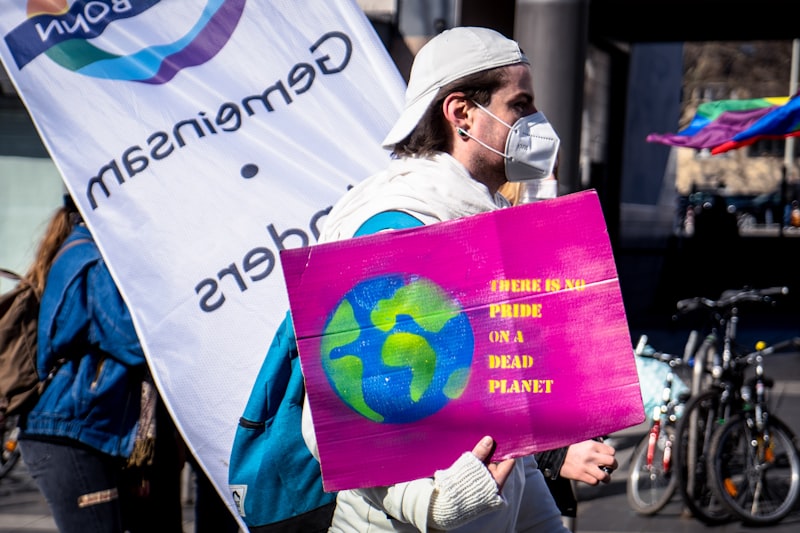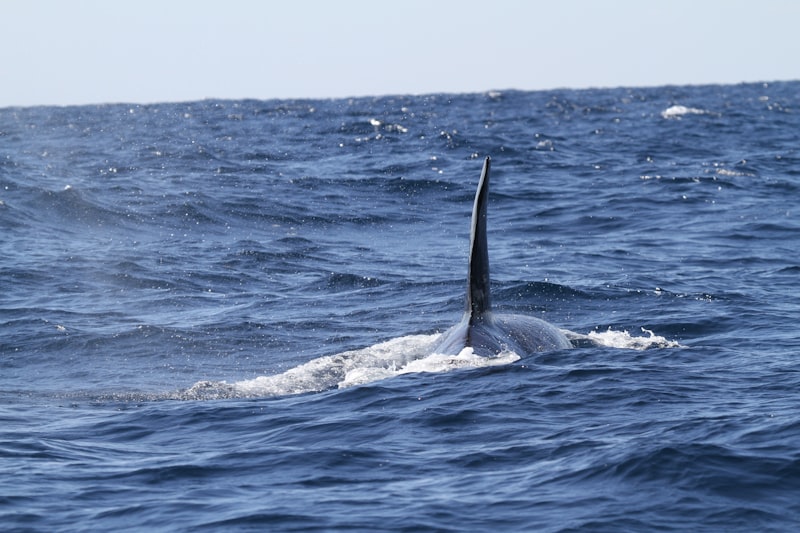One of the most visible impacts of climate change on marine habitats is the bleaching of coral reefs. Corals, which depend on a delicate balance of temperature and water quality, are highly sensitive to even slight changes in their environment. As oceans warm, corals expel the symbiotic algae living in their tissues, causing them to turn white—a process known as bleaching. This not only threatens the vibrant biodiversity these reefs support but also undermines the livelihoods of millions who rely on them for food and tourism.
Additionally, melting polar ice caps due to rising global temperatures are leading to sea level rise and altering marine ecosystems. Species like polar bears and seals are losing crucial habitat, forcing them to adapt or migrate, often with devastating consequences. The loss of sea ice also affects ocean currents and marine food webs, impacting species throughout the food chain, from plankton to whales.

Ocean acidification, another consequence of climate change, occurs as the oceans absorb excess carbon dioxide from the atmosphere. This acidification makes it harder for marine organisms such as shellfish and corals to build their shells and skeletons, threatening their survival and the ecosystems they support.
The implications of these changes are profound and far-reaching. Marine habitats not only provide essential ecosystem services like fisheries and coastal protection but also contribute significantly to global biodiversity. Protecting these habitats from further degradation requires urgent and coordinated international action to reduce greenhouse gas emissions, promote sustainable fishing practices, and establish marine protected areas.
As we continue to grapple with the effects of climate change, understanding and mitigating its impact on marine habitats will be crucial for the future health of our oceans and the billions of people who depend on them.
Oceanic Havoc: How Climate Change Threatens Marine Ecosystems
The impact of climate change extends beyond temperature and acidity changes. Melting polar ice caps contribute to sea level rise, flooding coastal habitats and altering ocean currents. This disruption can lead to unpredictable weather patterns, affecting marine breeding and migration cycles crucial for species survival. As habitats shift and degrade, marine species face challenges in adapting quickly enough to survive.
Human activities exacerbate these issues. Overfishing depletes fish stocks essential for marine food chains, while pollution from plastics and chemicals further stresses marine life. The cumulative effect is a compromised resilience in marine ecosystems, making them more vulnerable to climate-related stressors.
Efforts to mitigate oceanic havoc include global agreements to reduce carbon emissions, promote sustainable fishing practices, and establish marine protected areas. These measures aim to restore balance in marine ecosystems by reducing stressors and enhancing resilience to climate impacts. Public awareness and advocacy play crucial roles in supporting these efforts, driving policy changes and individual actions that collectively contribute to safeguarding marine biodiversity.
Addressing climate change is paramount to safeguarding marine ecosystems from oceanic havoc. By reducing greenhouse gas emissions, protecting marine habitats, and promoting sustainable practices, we can mitigate the adverse effects of climate change on our oceans and ensure a healthier future for marine life and coastal communities alike.
Sinking Seas: Climate Change’s Toll on Coral Reefs and Fisheries
Coral reefs, often referred to as the rainforests of the sea, are intricate ecosystems teeming with life. They provide a habitat for a quarter of all marine species, offering shelter, breeding grounds, and food sources crucial to oceanic life cycles. However, rising sea temperatures disrupt the delicate balance within these reefs. Corals, sensitive to even slight changes in temperature, expel the algae living in their tissues, a process known as coral bleaching. This phenomenon not only robs corals of their vibrant colors but also weakens them, making them more susceptible to disease and death.
Moreover, the acidification of ocean waters, caused by the absorption of excess carbon dioxide from the atmosphere, further threatens coral reefs. Increased acidity inhibits the ability of corals and other marine organisms to build their calcium carbonate skeletons and structures, essential for their survival and growth.
Beyond coral reefs, climate change poses a significant threat to global fisheries. Fish populations, already stressed by overfishing and habitat destruction, face additional pressures from warming waters and changing ocean currents. This shift alters migration patterns and disrupts breeding cycles, impacting the abundance and distribution of fish stocks worldwide.
The consequences of these environmental shifts extend far beyond marine life. Coastal communities that rely on coral reefs for tourism, food security, and storm protection are increasingly vulnerable. Economic losses are imminent as coral degradation diminishes fisheries yields and reduces the attractiveness of coral-dependent tourism.
Rising Tides, Diminished Coasts: Coastal Habitats Under Climate Stress
Imagine a shoreline where vibrant coral reefs once thrived, now struggling to survive as ocean temperatures rise beyond their tolerance levels. The rising tides bring not only warmer waters but also more frequent and severe storms, eroding coastlines and inundating low-lying habitats. Mangrove forests, essential buffers against coastal erosion and nurseries for countless marine species, are being threatened as saltwater intrusion increases.
The implications of these changes are profound. Coastal communities, reliant on fisheries and tourism, find their livelihoods at risk as fish populations migrate and beaches shrink. Erosion threatens infrastructure, homes, and cultural heritage sites, forcing difficult decisions about relocation and adaptation.

Yet, amidst these challenges, there is hope. Conservation efforts, like the restoration of marshlands and the creation of artificial reefs, show promising results in bolstering coastal resilience. Innovative technologies, such as sea walls designed to absorb wave energy without harming habitats, offer potential solutions to protect vulnerable shorelines.
As we navigate these turbulent waters, it becomes clear that the health of our coastal habitats is intricately linked to our own well-being. By understanding and mitigating the impacts of climate change, we can work towards safeguarding these invaluable ecosystems for future generations.
Survival at Stake: Marine Species Facing Extinction Due to Climate Change
Climate change, driven by human activities such as industrial emissions and deforestation, has disrupted marine ecosystems worldwide. Rising ocean temperatures have led to mass coral bleaching events, where corals expel the algae that give them their vibrant colors and main source of nutrition. Without these symbiotic algae, corals weaken and become susceptible to disease, ultimately leading to widespread mortality across reef systems.
Meanwhile, marine species face unprecedented challenges in adapting to rapidly changing environments. Fish populations are shifting towards cooler waters, seeking refuge from warming seas that threaten their survival. This migration disrupts established fishing patterns and poses significant challenges to communities dependent on marine resources for sustenance and livelihoods.
As ocean acidity increases due to higher carbon dioxide levels in the atmosphere, shell-forming organisms like oysters and planktonic species crucial to the marine food web struggle to build and maintain their calcium carbonate structures. This jeopardizes not only their own survival but also that of larger predators, including marine mammals and seabirds, which rely on them for sustenance.
The impact of climate change on marine ecosystems is not just an ecological crisis but also a human one. Coastal communities, particularly in developing countries, face heightened risks from extreme weather events and sea-level rise, threatening homes, infrastructure, and economic stability.
In the face of these challenges, urgent global action is needed to mitigate climate change and protect marine biodiversity. By reducing greenhouse gas emissions, expanding marine protected areas, and promoting sustainable fishing practices, we can safeguard the delicate balance of our oceans and ensure a sustainable future for generations to come.
Warming Oceans, Cooling Life: How Climate Shifts Affect Marine Biodiversity
Imagine the ocean as a vast, interconnected ecosystem where every species, from the smallest plankton to the largest whales, plays a crucial role. With rising global temperatures, the oceans are absorbing much of this heat, causing them to warm at an alarming rate. This warming directly affects marine life in numerous ways.
For many marine species, temperature is critical for survival and reproduction. A slight increase in water temperature can disrupt breeding cycles, alter migration patterns, and even lead to the loss of habitat such as coral reefs. Coral reefs, often called the rainforests of the sea, are particularly vulnerable. Warmer waters stress the corals, leading to coral bleaching—a phenomenon where corals expel the algae living in their tissues, turning them white and depriving them of their main energy source.
On the other hand, while some parts of the ocean warm, others experience cooling due to changes in ocean currents and circulation patterns. This cooling can also have significant effects on marine life. For instance, species that thrive in cooler waters may find their habitats shrinking or shifting poleward as temperatures rise elsewhere.
These climate shifts create a complex web of challenges for marine biodiversity. Adaptation is key, but many species face an uphill battle against rapid environmental changes. The implications extend beyond the marine realm, affecting human communities that rely on fisheries and coastal resources for livelihoods.
From Bleached Coral to Empty Seas: Climate Crisis’s Grim Impact Below the Surface
Imagine a bustling coral reef, teeming with a kaleidoscope of marine life. Schools of fish dart through intricate coral structures, while sea turtles gracefully glide by. This vibrant scene is not just beautiful; it’s crucial for the balance of our oceans. Coral reefs are often called the rainforests of the sea, harboring immense biodiversity and providing essential services like coastal protection and fisheries support.
However, the relentless rise in global temperatures has pushed these delicate ecosystems to the brink. Coral bleaching occurs when corals expel the algae living in their tissues, turning them ghostly white. This phenomenon is not merely a cosmetic issue; it’s a sign of distress. The algae, crucial for the coral’s survival, provide them with food and vibrant color. Without them, corals weaken and become susceptible to disease and death.
But why does this matter beyond the beauty of reefs? Coral reefs support over a quarter of all marine life, despite covering less than 1% of the ocean floor. They are lifelines for millions of people who depend on them for food, income, and protection from storms. Imagine a city suddenly losing its infrastructure; that’s what happens when coral reefs decline.
The implications are far-reaching. As coral reefs disappear, fisheries suffer, coastal communities lose their defenses against storms, and biodiversity plummets. It’s a ripple effect that touches every corner of our planet.
Scientists warn that without urgent action to curb greenhouse gas emissions and protect these fragile ecosystems, we may face a future where coral reefs become a rare sight. The choice is ours: to continue down this path of destruction or to take decisive steps to preserve our oceans and the countless lives they support.
Changing Currents: Climate Variability and Its Ripple Effect on Marine Habitats
Picture the ocean currents as nature’s circulation system, constantly moving and distributing heat and nutrients around the globe. These currents aren’t just water in motion; they’re critical highways that marine species rely on for migration, feeding grounds, and even breeding. But here’s where climate variability comes into play—it disrupts this finely tuned system.
Think of it like this: imagine a clock where each gear and cog fits perfectly together to keep time. If you tweak one gear, however slightly, the entire clock’s function is affected. Similarly, climate variability alters ocean currents, changing temperatures, and patterns of nutrient distribution. This directly impacts the marine habitats that depend on stable conditions.
For instance, warmer ocean temperatures can lead to coral bleaching—a devastating process where corals expel algae living in their tissues, turning vibrant reefs ghostly white. This isn’t just an aesthetic issue; coral reefs are biodiversity hotspots crucial for countless marine species. Without them, entire ecosystems collapse like a house of cards.
But it’s not just about warmer waters; climate variability also influences ocean acidity levels and the frequency of extreme weather events like hurricanes and cyclones. These changes pose additional threats to marine habitats already struggling to adapt.
So, what can be done to mitigate these impacts? Understanding the intricate links between climate variability and marine habitats is the first step. From reducing carbon emissions to establishing marine protected areas, concerted global efforts are essential. After all, a healthy ocean isn’t just crucial for marine life—it’s vital for our planet’s overall health and our own survival.
Frequently Asked Questions
What are the main effects of climate change on marine habitats?
This FAQ provides a concise overview of the primary impacts of climate change on marine habitats. It focuses on how rising temperatures, ocean acidification, and changing currents affect marine ecosystems, including coral reefs, fish populations, and coastal habitats.
How does ocean acidification affect marine life?
Learn how ocean acidification impacts marine life, affecting the growth of shells and skeletons in organisms like corals and mollusks. Discover its broader effects on ecosystems and the future of ocean biodiversity.
What measures are being taken to protect marine habitats from climate change?
Discover how marine habitats are safeguarded against climate change through various conservation efforts and protective measures.
How can climate change impact coral reefs and their ecosystems?
Learn about the profound effects of climate change on coral reefs and their ecosystems. Discover how rising temperatures, ocean acidification, and extreme weather events threaten coral health, biodiversity, and the livelihoods that depend on these fragile marine environments.
What species are most vulnerable to climate change in oceans?
Discover which ocean species are most vulnerable to climate change with our concise FAQ. Learn about the specific marine creatures at highest risk and why they are particularly sensitive to environmental shifts.


